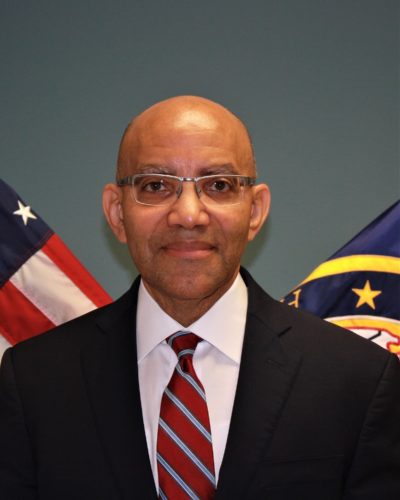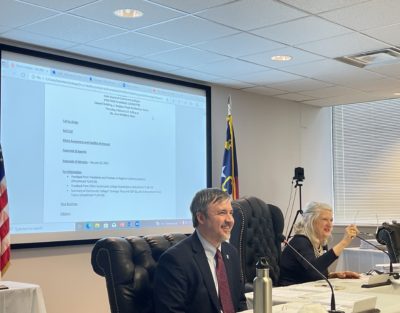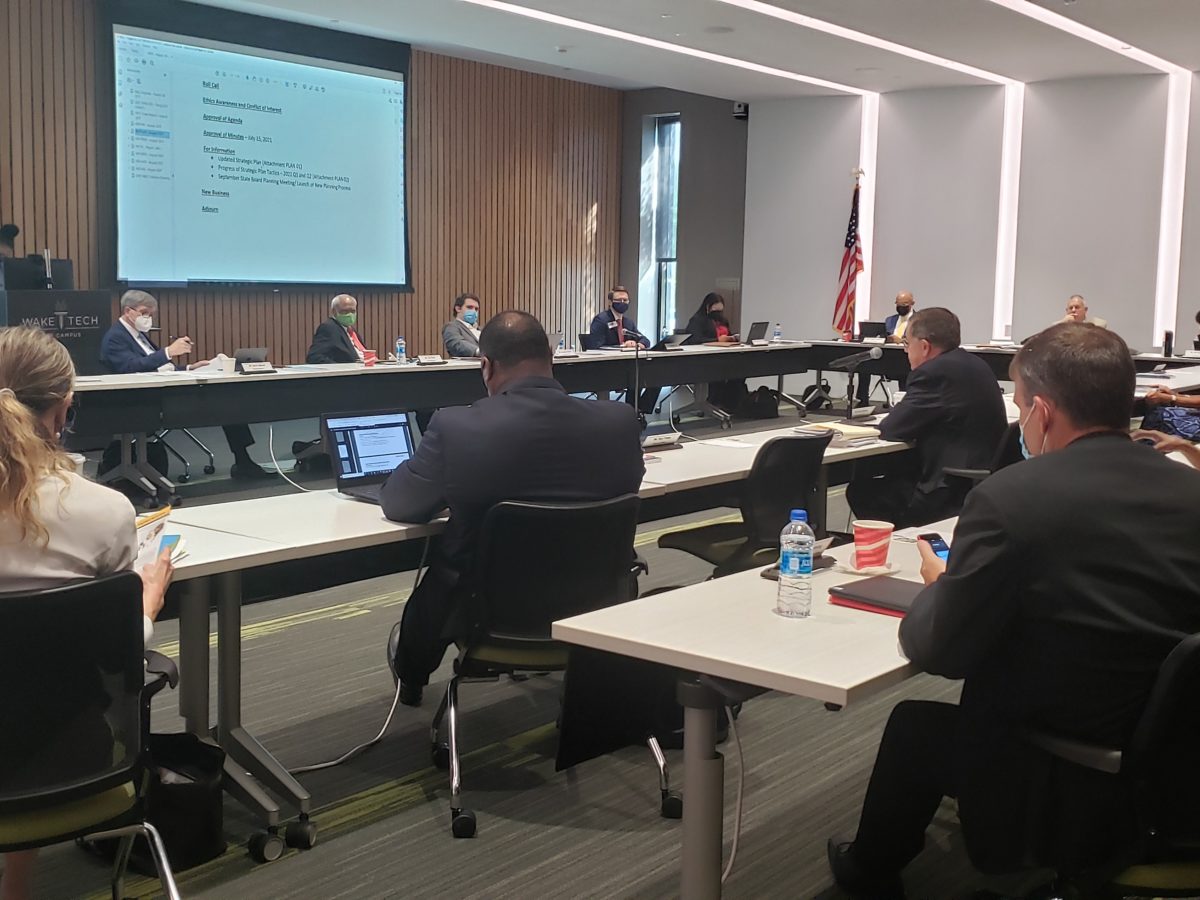
|
|
When State Board of Community Colleges Chair Burr Sullivan kicked off the Board’s first meeting of 2022, he welcomed a lot of new faces.
Within the last few months, nearly half of the Board members turned over. On paper, this isn’t possible. But with two members resigning, the number of new members swelled in fall 2021.
Having this many new members at one time is a challenge for the Board, Sullivan explained. They need time to adjust to being on the Board, their responsibilities, and the community college landscape in North Carolina.
But Sullivan also sees this as an opportunity – these members all bring unique talents at a pivotal time for the system. They’re members of the state legislature, business owners, and experienced educators.
This isn’t the only new thing for the system. Many colleges across the state welcomed new presidents in the last year, and North Carolina Community College System (NCCCS) President Thomas Stith is looking toward his second year after visiting all 58 colleges last year.
It’s a time of opportunity with a lot to get done, but these leaders also recognize that it won’t be easy.
Sign up for Awake58, our newsletter on all things community college.
A Board in transition
To put it in a word, Sullivan says he’s busy. He says he expected former Chair Breeden Blackwell to be reappointed when his term expired over the summer. When that didn’t happen, Sullivan didn’t expect that he would be chair.
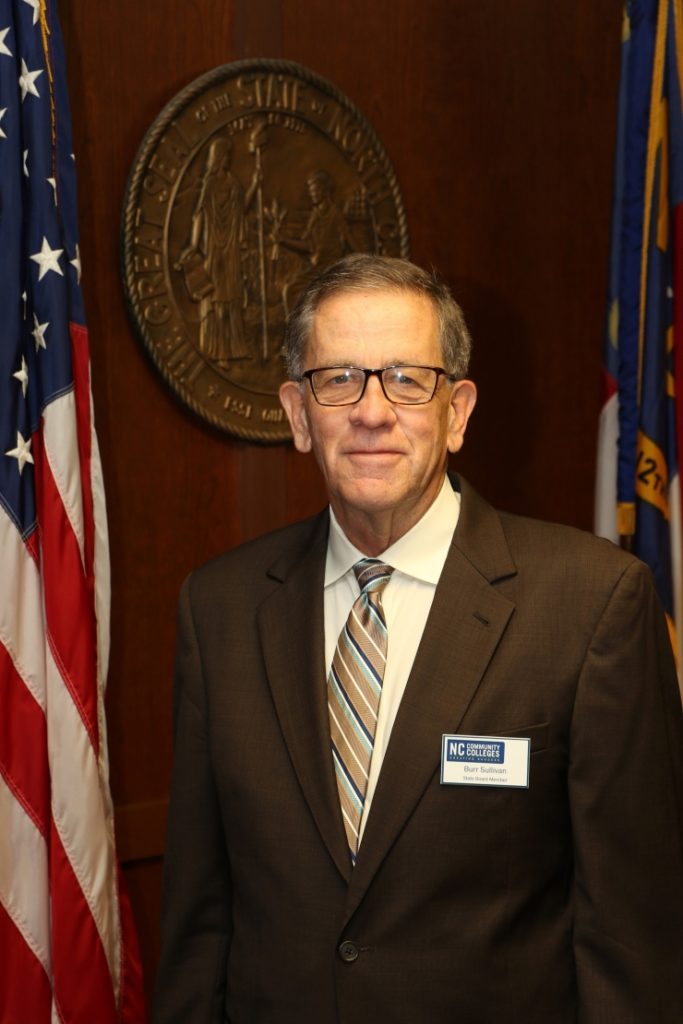
But after a 11-8 vote, Sullivan took charge of the Board. He beat out Board member Lisa Estep, who was recently reappointed.
After serving on the Board for four and a half years, the Board he is leading looks very different now.
He emphasized that leading the system is a group effort, and one of his main priorities is getting the new members up to speed.
Here’s a look at the new appointees in the last year:
- Lee Barnes (appointed by the House)
- Shirley Carraway (appointed by Gov. Cooper)
- Tom Looney (appointed by the Senate)
- Andy Penry (appointed by Gov. Cooper)
- Sam Searcy (appointed by Gov. Cooper)
- Ray Trapp (appointed by Gov. Cooper)
- Sarah West (appointed by Gov. Cooper)
In addition, Terry Van Duyn and Ray Russell were welcomed at the end of 2021 to finish out the terms of other members. Board Vice Chair Bill McBrayer was reappointed by the House last year, and Lisa Estep was reappointed by the Senate after being off the Board for a brief time.
Including recently elected Lt. Gov. Mark Robinson, that’s 10 new members within the last year — almost half of the Board.
Though these are a lot of new faces with varying degrees of experience in education, Sullivan said he recognizes that there’s a lot of talent. It’s just a matter of honing that talent by asking people what they want to do, and pairing those skills and interests with what the system needs.
So Sullivan said he’s been intentional about not only speaking with new members about what their strengths are, but placing them on committees. Two new Board members — Lee Barnes and Ray Trapp — chair committees.
Sullivan said he doesn’t want to face another situation like this past summer, where the rotation of membership led to brain drain.
Though that may not be interesting to the general public, he said, it’s important to him because without effective leadership, the Board can’t carry out its strategic plan.
Starting in September, the Board has been in the process of developing a new strategic plan. Board and system staff have spent the last several months conducting listening sessions across the state to hear from college stakeholders. Several key challenges have been highlighted at these nine regional sessions, including recruitment and retention of faculty and staff, enrollment, funding, and data.
In addition to developing a new strategic plan, the Board approved in January a three-year legislative agenda, which includes an 8% salary increase for community college personnel, and its first-ever self review.
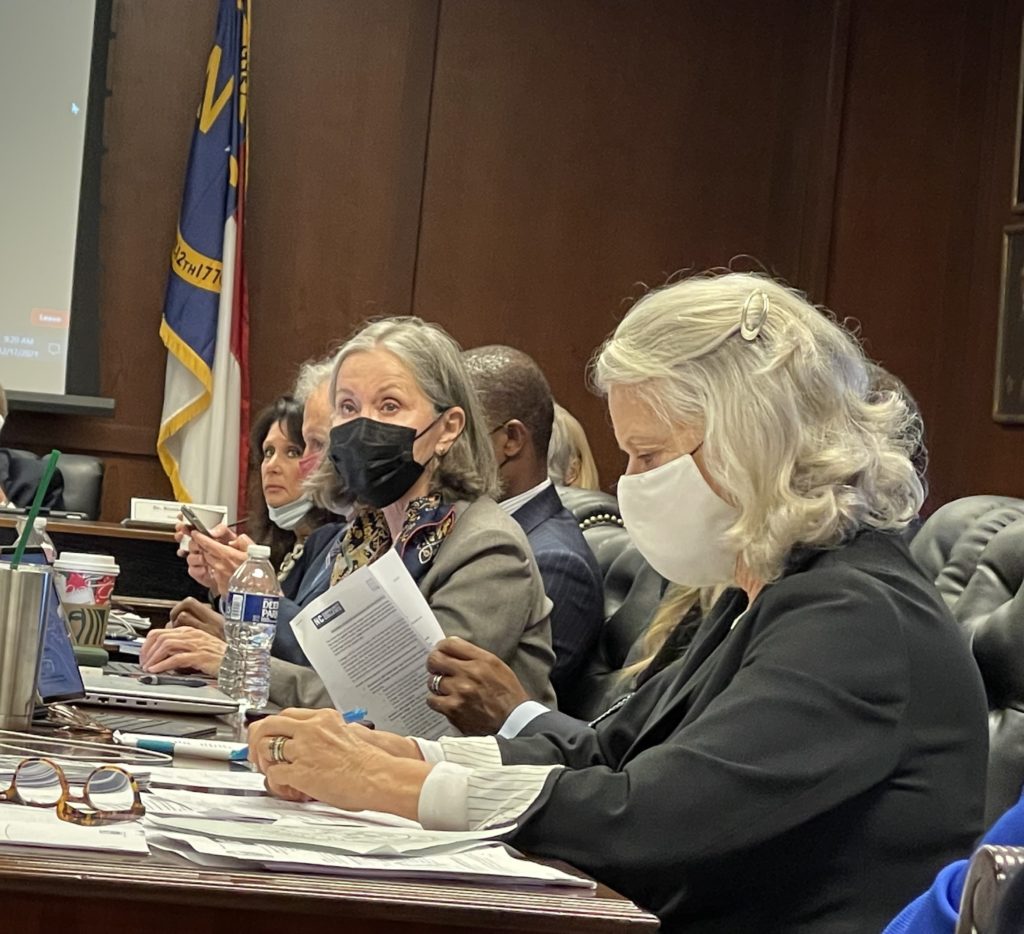
Board member Ann Whitford, one of the members leading the evaluation, said she had to participate in a Board self-evaluation each year when she was a college trustee, yet this Board has never done one.
“Evaluation of the Board provides an opportunity to take stock, establish an agenda around emerging issues and needs, and it strengthens the Board and president relationship,” she told the Board at the January meeting.
Board member Sarah West, who is also leading the evaluation process, said the importance of having a functional Board at this particular moment can’t be overstated.
“The North Carolina Community College System (System) has faced massive disruptions in our local and global landscape and in our higher education systems,” reads the draft survey. “The System plays an increasingly vital role in driving the economic and societal well-being of our state and citizenry. A high-performing Board of Directors is critical to System success and can lend important support to the System Office at this pivotal moment.”
Having a shared vision is foundational to the system’s success, West said.
Sullivan said he also hopes to revive the Community College Foundation, thanks to the leadership of newly appointed Executive Director Grant Godwin. The foundation is a valuable partner, Sullivan said, not only for moral support but also for financial support.
Godwin explained to the Board in February that the foundation is separating its staff from the system office.
“It will enable us to be more progressive, more aggressive, more attentive to what the needs and interests are of the system office, the State Board, and the 58 colleges,” Godwin said.
Thomas Stith celebrates one year in office
As the State Board is embarking on its first review, President Thomas Stith also recently celebrated a milestone – completing his first year in office.
He said that he has visited all 58 community colleges last year, and the lessons he has learned on these visits are informing his strategy for this next year.
“Our stakeholders are key to the success of the community college system, and we’ll continue to pursue building and developing new relationships as we move forward,” he said.
He and the Board seem to focus on a lot of the same things, like utilizing the recently passed state funding and building on the success of the adult learner pilot. He has also emphasized that he wants to make sure North Carolina’s community colleges are an “engine for economic recovery” as the state navigates the pandemic.
At the same time that the State Board has seen a lot of turnover, so has the system overall.
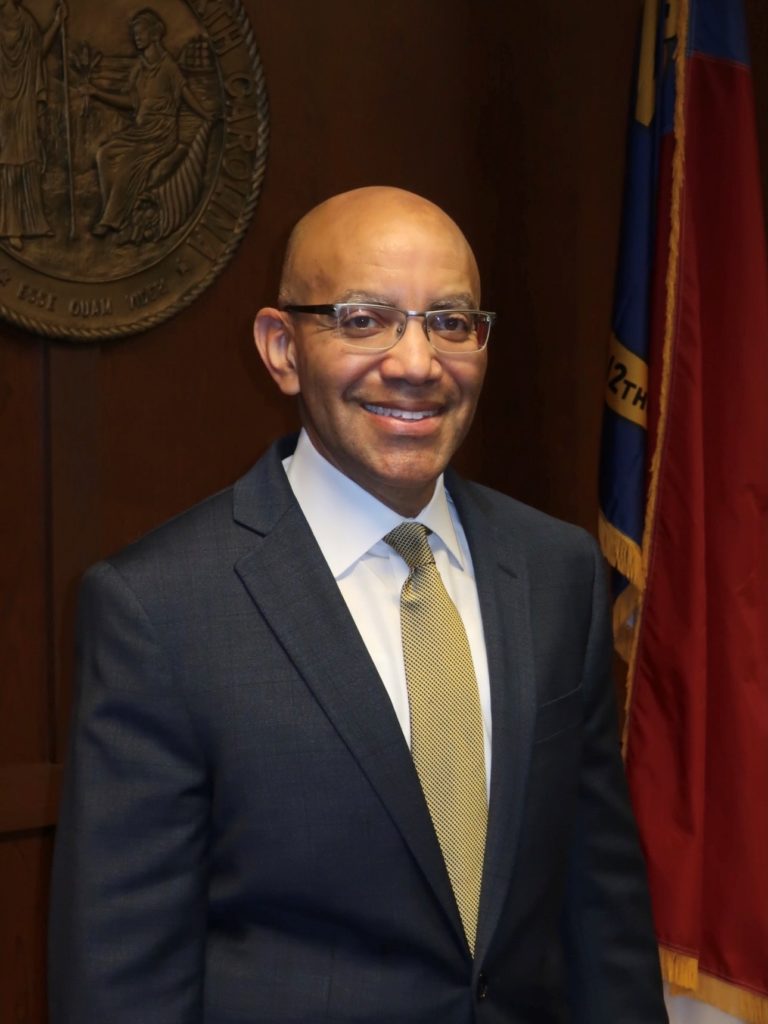
Stith is the sixth president the community college system has had in about as many years. During that same time, there has been a lot of turnover in presidential roles at individual colleges.
Since 2019, new presidents have started serving at 24 of the system’s 58 community colleges, and multiple colleges are actively searching. The presidents of Fayetteville Technical Community College and Randolph Community College announced their retirements at the beginning of this year.
The system’s executive office has also seen a lot of turnover, a trend that started after former president Peter Hans announced that he was leaving. Within the last year, nearly every member of the president’s office has left. (Kim Gold left her position as chief academic officer to become the chief of staff.) Most recently, Chief Financial Officer Elizabeth Grovenstein announced her retirement.
Stith said he sees these staffing changes as an exciting time for the system.
“We’ve been able to continue to build a team for the future … All employers within the public and private sector are recognizing that change is happening in the workforce. But my focus is on connecting, engaging and embracing that change, and building a team that will propel the community college system in the future.”
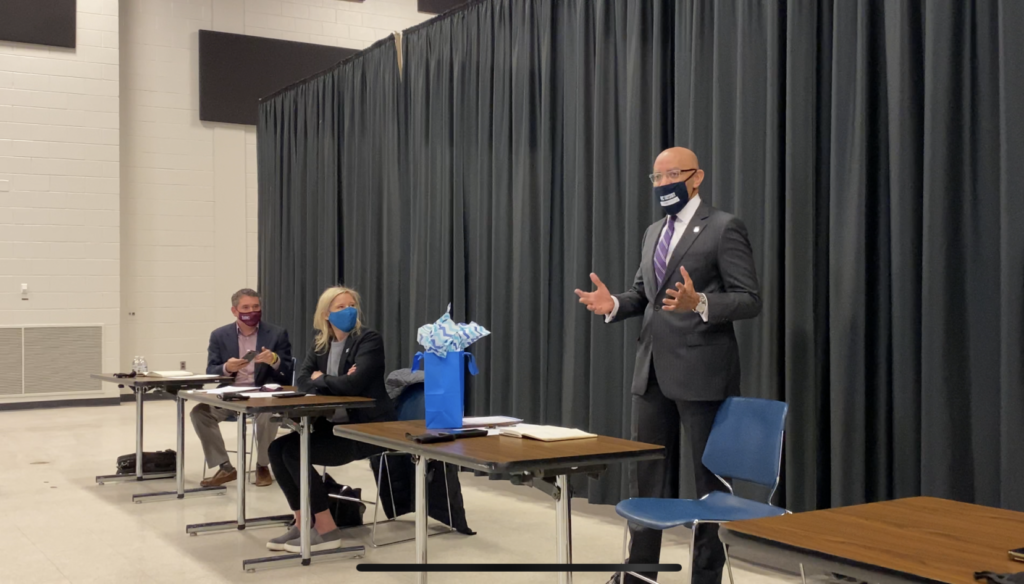
The system office launched an “organizational assessment” in December 2021 to “ensure that it is properly resourced and aligned with stakeholders to meet its vision and mission,” according to a press release.
At the Board’s January meeting, Stith received his one-year review. The review, which lasted over three hours, was conducted in closed session, which is typical for a personnel matter.
Though he wasn’t able to comment on any specifics, he said the process showed how passionate Board members are about the system.
“Not only do we have a good number of new Board members, and they bring new perspective, passions, and talent, they’re joining a Board that is highly committed, and equally passionate individuals,” he said. “It (the review) was a robust process, and it clearly showed that both the Board and I are deeply passionate about the success of the Great 58. And ultimately, what we all are focused on is student success.”
All of these changes come at a critical time for the community college system in North Carolina.
The system and individual colleges have an influx of funds to spend, thanks to federal COVID-19 relief dollars and the recently passed budget. The pandemic caused a sharp drop in enrollment from which the system has not fully recovered. And the possibility of a merger of the UNC System with the community college system bubbled up after the recent budget included funding for a study to move the UNC System Office to the downtown government complex in Raleigh and almost $11.4 million non-recurring for the planning and design of the new UNC System Office.
With all these challenges and opportunities, it’s an especially important time to be a community college leader in North Carolina. That mentality is what’s guiding leaders like Sullivan going forward.
“The sun is shining over community colleges in America,” Sullivan said. “Now, are we where we need to be in terms of convincing parents that they need to get off on the insistence that their child can go only to a four-year school? No, we’re not there yet. But there are tremendous opportunities in front of us.”
Recommended reading
